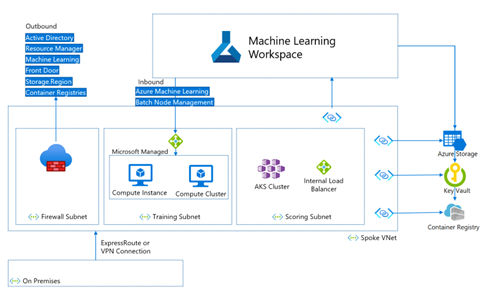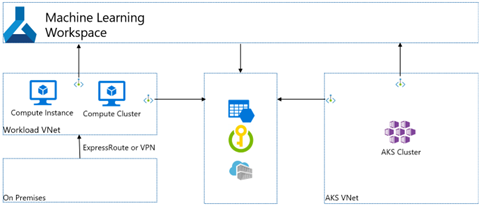You’re starting your journey into Azure Artificial Intelligence (AI) and Machine Learning (ML), but you are concerned when it comes to security. You’re certainly not alone – and good job thinking about it early!
At Agile IT, many of our clients have the following concerns, which it looks like you do to:
- How can we ensure our AI-driven initiatives remain secure from potential threats?
- What measures should we adopt to guarantee data privacy and compliance in an AI-driven environment?
- What are some key considerations when designing virtual networks for AI and ML?
If these questions resonate with you, you’re in the right place. This blog aims to provide you with an introduction to AI and ML enterprise security. By the end of this article, you’ll be familiar with some basic concepts relating to AI and ML security landscape, virtual network and private endpoint design, workspace access management, and more.
Understanding the AI and ML Security Landscape
In the realm of AI and ML, security isn’t just an afterthought—it’s a foundational element. As you embark on your AI and ML journeys, you will probably grapple with the complexities of ensuring your initiatives are both innovative and secure.
1. The Importance of a Robust Network Security Architecture:
A well-structured machine learning network security architecture is crucial. It typically encompasses:
- Training subnets: These contain the compute resources dedicated to training.
- Scoring subnets: Here, the compute resources are focused on scoring.
- Firewall subnets: These manage traffic to and from the public internet.
Many organizations, including some of our Agile IT clients, are wondering what the best way is to structure these subnets to ensure optimal security. Tailoring the architecture to the unique needs of your organization is key.
2. Workspace Access Management:

This involves meticulously determining who can access what within the AI and ML workspace. Microsoft Entra, formerly known as Azure AD, emerges as a beacon in this landscape, offering a suite of tools tailored to address these challenges. Whether you’re looking at patterns like self-service, data-centric, or project-centric, Entra adapts to your organizational needs, making it imperative to grasp the unique dynamics of your team and projects for optimal configuration. Here are some of the benefits of Entra:
- Unified Identity Management: Centralizing your identity management can streamline access controls, making it easier for you to manage permissions across various services and applications. By having a single source of truth for identities, you can ensure consistent access controls and reduce potential security risks.
- Granular Access Control: With Entra, you can define granular access controls for your AI and ML workspaces. This ensures that only authorized individuals or groups can access specific resources, datasets, or models.
- Role-Based Access Control (RBAC): Implementing RBAC allows you to grant access based on roles within the company. This ensures that your team members only have access to the resources they need to perform their job functions, enhancing security and reducing potential data breaches.
- Multi-Factor Authentication (MFA): MFA adds an additional layer of security by requiring two or more verification methods. This can significantly reduce your risk of unauthorized access, even if login credentials are compromised.
- Integration with Other Azure Services: Azure AD seamlessly integrates with other Azure services, making it easier for you to manage access to various resources, including your AI and ML workspaces, storage accounts, databases, and more.
For a comprehensive understanding of identity and access management best practices, refer to Agile IT’s insights on Microsoft Entra Expert Identity Management Solutions.
3. Virtual Network and Private Endpoint Design:

When it comes to designing virtual networks and private endpoints for AI and ML, we recommend paying attention to key considerations:
- Separate Subnets: Always have distinct subnets for training and scoring. This segregation ensures that each process runs efficiently without interference.
- IP Addressing: Properly plan your IP addressing requirements. This is foundational to ensure smooth communication within the network.
- Private Endpoints: Implement private endpoints for storage accounts, key vaults, and container registries. These endpoints enhance security by ensuring that only authorized entities can access your critical data and configurations.
- Functional and Secure Designs: It’s essential to strike a balance between functionality and security. While your virtual network should support all your AI and ML operations, it shouldn’t compromise on security.
Ensuring that virtual network designs are both functional and secure is a common concern. By following best practices and seeking expert guidance, these challenges can be effectively addressed. For a deeper dive into best practices for designing virtual networks for AI and ML, check out this reference from Microsoft.
Conclusion
The integration of AI and ML into enterprise security is not just a trend but a necessity in the modern digital age. If you’re on your journey to using AI within your organization, security and compliance are critical components as part of your planning and adoption.
Our experts at Agile IT’s are ready to guide you every step of the way. With our tailored solutions, we’ll ensure your organization is not only prepared but also primed to tackle future security challenges head-on. Don’t journey alone; let Agile IT be your trusted partner in this transformative journey.
Published on: .